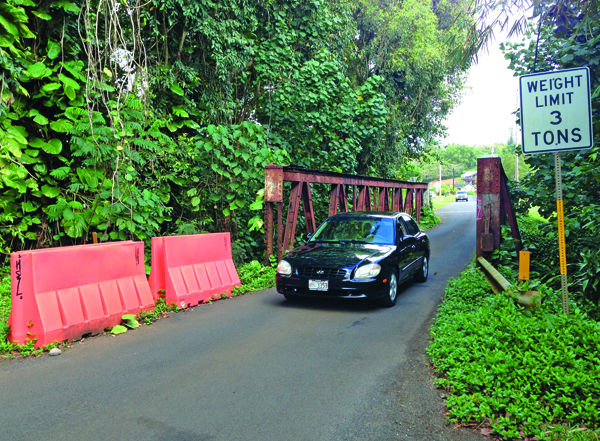LIHU‘E — The one-lane bridges that enhance Kaua‘i’s rural lifestyle should stay that way, says Andy Bushnell. “When you drive up to the bridges, you know you have to stop, and you do. And you wait for the other person
LIHU‘E — The one-lane bridges that enhance Kaua‘i’s rural lifestyle should stay that way, says Andy Bushnell.
“When you drive up to the bridges, you know you have to stop, and you do. And you wait for the other person to come by, and you go, ‘How’s it brah?’ because this is an opportunity to say hello,” said the Kapa‘a Homestead resident of 41 years and a retired history professor at Kaua‘i Community College.
Bushnell was one of several people who testified Wednesday during an update from the administration to the Kaua‘i County Council on the status of repair and maintenance of the island’s bridges.
Kaua‘i has 85 bridges, including culverts, according to county officials. Twenty-six of these bridges (the ones that are at least 20-feet long) are on the National Bridge Inventory.
Most of Kaua‘i’s bridges, because of their age, need to be considered to be listed as historical, said Ken Teshima of the county Public Works Department. He said there are only six bridges on the county’s inventory that don’t meet historical qualifications.
County Engineer Larry Dill said restoring the bridges is a challenge.
“There are folks that are passionate about these bridges,” Dill said.
He said the administration tries to do its best to meet residents’ requests, but there are financial constraints and the county must follow engineering requirements.
The county is trying to find solutions for the historical ‘Opaeka‘a, Pu‘u‘opae, Kapahi, Hanapepe and Kapaia bridges. Some of the plans have taken a step back and are being revised after meeting with residents and with the Kaua‘i Historic Preservation Review Commission, Dill said.
Laraine Moriguchi of the Kapaia Foundation has been working to save the Kapaia Swinging Bridge, a pedestrian walkway closed years ago for safety reasons.
The bridge sustained further damage during last year’s March rains.
“Kapaia Foundation whole-heartedly supports preserving the historical integrity of ‘Opaeka‘a, Pu‘u‘opae, Kapahi and Old Hanapepe bridges,” said Moriguchi.
Gary Mack has lived on Kahuna Road for 22 years, and goes over Kapahi Bridge daily. He said he has never seen a traffic jam there.
“I’d like to see that bridge really maintain the quality of historic value and also the aesthetics of a rural neighborhood,” Mack said.
Kapahi Bridge cannot accommodate emergency vehicles, according to Dill. He said if the county adds a foot-and-a-half to the bridge’s 14-foot width, this problem would be solved. But there are also structural issues that need to be addressed to allow a heavier load capacity.
Kahuna Road resident Francesco Garapoli said “the big thing” about Kapahi Bridge is that it’s used by many families as a picnic and hang out area.
“It’s not always what goes over a bridge, but what goes under a bridge,” he said.
He asked county officials to consider the heritage quality of the island.
“It would be such a sad moment if that bridge was changed,” Garapoli said.
Hanapepe resident Dorothea Hiyashi brought a petition to the council signed by many Westside residents calling for restoration of Hanapepe Bridge.
“We the residents of Hanapepe and Kaua‘i would like the bridge built in 1911 restored to its original state including the iconic elevated walkway,” she said.
The county’s current plans for Hanapepe Bridge are to replace its elevated walkway — which has been closed for a few years — with one that is level with the road.
Dill said there is a strong segment that wants one-lane bridges replaced with two-lane bridges. But he wasn’t sure of the need for two lanes on some of those bridges, so a study is being done that should be ready in four weeks.
Kapa‘a resident Glenn Mickens and Lihu‘e resident Joe Rosa were some of the few who criticized the single-lane design, specially regarding safety.
Mickens had a letter from Alvin Takeshita, of the state Highways Division, stating that one-lane bridges are twice as much accident prone than two-lane bridges, based on statistics from 2004 to 2009.
However, half of all accidents on one-lane bridges happened on Hanalei Bridge, which is heavily traveled, according to Takeshita’s letter.
Bushnell said the community agrees with Mickens that bridges should be safe. They just don’t agree that one-lane bridges are more dangerous, especially because cars are forced to slow down while crossing single-lane bridges.
One of the great things about Pu‘u‘opae and ‘Opaeka‘a bridges is that they have calming effects on traffic, according to Bushnell.
“We want to keep (Pu‘u‘opae) Bridge the way it is, if we possibly can,” he said.
Moving forward
Teshima said the administration needs to develop a program addressing all bridges.
The county has a process to identify NBI bridges by numbers, and will extend it to address all other bridges. It’s impossible to manage it all without a complete inventory, Teshima said.
“The NBI has a strict set of standards, national bridge inspection standards, that must be followed,” he said.
Dill said Public Works is moving toward an asset management program for the bridges, along the lines of what the department’s Roads Division is doing with roads. The program will help identify minor repairs on an ongoing basis to keep the bridges in better shape, he said.
Teshima said he has a map that shows all of Kaua‘i’s bridges and culverts, and each one needs the same attention relative to age, condition, location and loading.
The way that the county would look at the bridges, based on the criteria, needs to be developed in a program, he said.
Public Works plans to apply some of same data that the law requires for NBI bridges to non-NBI bridges and culverts, according to Teshima.
“There is a substantial amount (of bridges and culverts),” he said. “Because of the quantity, we really need to get a handle on all of these things.”


